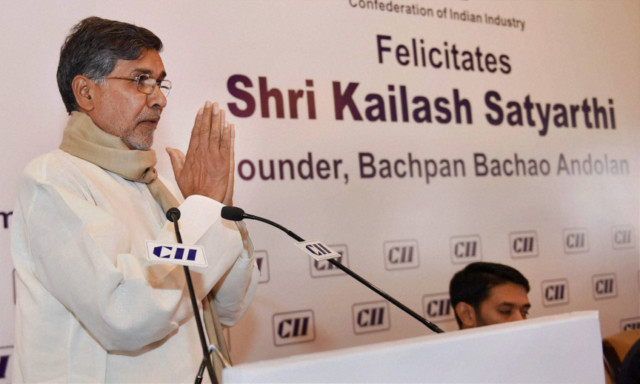
For years Chandra Shekhar, India’s Prime Minister from 1990-91, hardly figured in any political discourse. But his name is suddenly echoing on national television thanks to Kailash Satyarthi, co-winner of the Nobel Peace Prize. The new Nobel Laureate is regaling prime-time audiences with untold stories of how Shekhar [who passed away in 2007] had threatened to fix him if he didn’t stop his campaign against child labour which Shekhar felt was instigating Western countries to contemplate slapping trade sanctions on exports like carpets made by India’s underage workers.
Apparently, Shekhar was not the only Indian PM to talk tough. Other PMs too ordered him to be “positive” rather than “negative” in the national interest.
The maverick who is the toast of India today was branded a traitor and foreign agent by the Indian establishment for over two decades. If Narendra Modi promptly hosted Satyarthi and posted photographs hugging the man of the moment on social media, it’s a tribute to the power of awards instituted by Alfred Nobel. The Nobel Peace Prize particularly is an honour which even heads of state envy!
Fortunately, the Nobel Prize hasn’t cramped Satyarthi’s style. After the award, he reiterated that the 83,500 children he has rescued from bonded labour so far is just the tip of the iceberg — there are still 140 million working children in India, including 55 million trapped in child slavery.
These are very damning statistics for a nation crowing with delight after sending a spaceship to Mars and demanding membership of the UN Security Council. Even as he is being felicitated, Satyarthi is rubbing it in that Delhi’s power elite willfully engage child servants in their sprawling official residences in the most exclusive zones of the national capital.
Satyarthi founded an NGO in 1980 — Bachpan Bachao Aandolan (Save Childhood Movement) — to combat child slavery and trafficking rampant in the country. If the administration refused to act, he and his supporters would storm factories employing child labour to liberate underage workers.
He was severely beaten during a “raid” he led on a circus to free trafficked teenaged girls. From the very beginning he was determined to eradicate child exploitation and promote child rights issues on a war footing.
But politicians — whose backing is crucial for the success of any initiative in a country like India — didn’t support BBA for two reasons. Firstly children didn’t have voting rights and were therefore not a deciding factor in election results which are a priority for any self-respecting politician. Secondly, child traffickers invariably operated hand in glove with corrupt elected representatives who reaped huge financial benefits from the organised racket.
Satyarthi’s disillusionment with India’s political and administrative machinery forced him to turn to Western trade unions, NGOs and United Nations for help to fight what he felt was a social menace and a crime against humanity. His collaboration with foreigners triggered an unprecedented vilification campaign by Indian government agencies which pulled out all stops to tarnish his image.
Retired Indian diplomat T.P. Sreenivasan, who oversaw New Delhi’s engagement with the UN, told The Telegraph that everyone criticising India’s child rights record used Satyarthi’s data. India was in a spot in 1989 when UN tabled a Convention on the Rights of the Child which required all countries to give in writing that there would be no exploitation of children.
Sreenivasan recalled that given India’s “economic and social stage of development”, it was very difficult to give in to demands that India immediately sign and ratify the Convention. During Shekhar’s prime ministership, when India stood its ground, Satyarthi approached the International Labour Organisation and foreign aid groups to pile pressure on New Delhi.
Ultimately India ratified the Convention in 1992. It’s another story altogether that India’s child labour laws lack teeth and are still full of loopholes which are easily exploited. But in Sreenivasan’s words: “Satyarthi changed the way the Government of India approached the issue of child labour, and there’s nothing wrong in what he achieved. But there’s a major problem with the way he achieved it — by using foreign countries to pressure India.”
What outraged New Delhi most was seeing US lawmakers like Senator Tom Harkin, European child rights activists and British Prime Minister Gordon Brown taking up cudgels on Satyarthi’s behalf and backing him to the hilt in his running battle with successive Indian regimes.
Modi greeted Satyarthi no sooner the Nobel Peace Prize was announced. But Modi groupie Madhu Kishwar has held the activist responsible for a global boycott of Indian carpets and demanded an audit of his funds — particularly the $2 million (Dh7.34 million) she claims German and American foundations raised for a march against child labour 12 years ago.
Obviously there is a lot of bad blood between Satyarthi and the Indian State. Let’s see whether he lands the Bharat Ratna — the nation’s highest civilian honour — or not.
Amartya Sen and Mother Teresa won the Nobel Prize in 1998 and 1979 respectively — and they were conferred the Bharat Ratna the very next year. Besides the baggage of history, Satyarthi may have shot himself in the foot by announcing that he doesn’t go to temples.
— S.N.M. Abdi is a noted Indian journalist and commentator.










